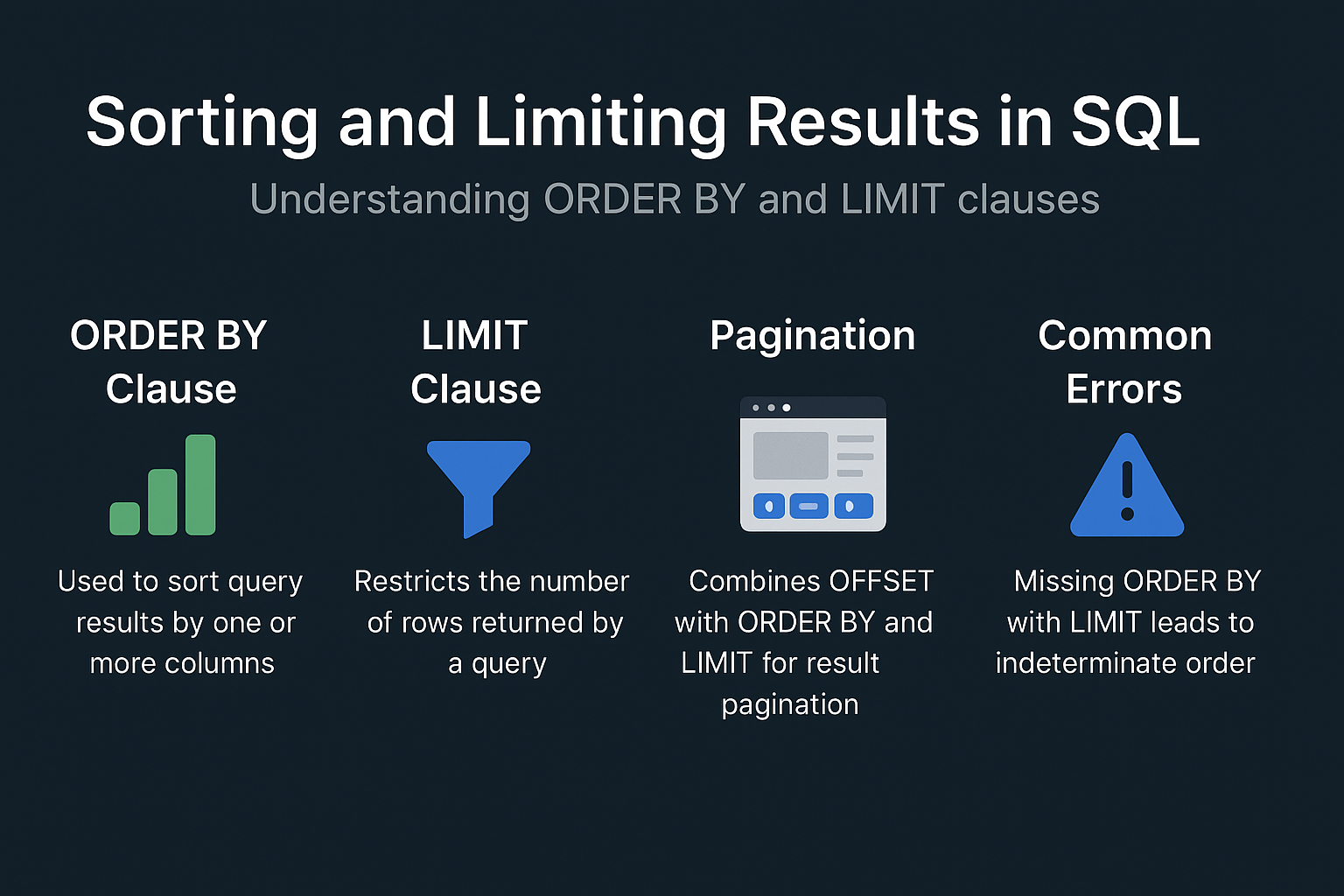Introduction
Sorting and limiting query results are essential for presenting and optimizing data. Whether you're fetching top customers, recent transactions, or paginated records, ORDER BY and LIMIT (or equivalent) are the go-to SQL tools.
Why It Matters
- Helps prioritize relevant data (e.g., most recent, top-selling).
- Reduces the data fetched for better performance.
- Enables pagination in APIs and applications.
Real-world analogy:
Sorting and limiting is like sorting a list of products by price and only viewing the top 10. SQL provides this functionality through ORDER BY and LIMIT clauses.
Core Concepts
ORDER BY Clause
Sorts the result set based on one or more columns.
SELECT name, signup_date
FROM customers
ORDER BY signup_date DESC;
LIMIT Clause
Restricts the number of rows returned.
SELECT name FROM customers LIMIT 5;
OFFSET Clause
Skips a specified number of rows before returning the result.
SELECT name FROM customers ORDER BY name LIMIT 5 OFFSET 10;
SQL Examples
Sort by Single Column
SELECT name, signup_date
FROM customers
ORDER BY signup_date ASC;
Sort by Multiple Columns
SELECT name, city, signup_date
FROM customers
ORDER BY city ASC, signup_date DESC;
Get Top N Records
SELECT * FROM orders
ORDER BY order_total DESC
LIMIT 10;
Pagination with OFFSET
SELECT * FROM products
ORDER BY product_name ASC
LIMIT 10 OFFSET 20; -- Page 3 (assuming 10 items per page)
Real-World Use Cases
- E-commerce: Display latest or most expensive products.
- Banking: Fetch most recent transactions.
- CRM: View top 10 customers by revenue.
Common Mistakes and Anti-Patterns
- Missing ORDER BY with LIMIT: Returns unpredictable results.
- Using OFFSET without index: Can cause performance issues on large datasets.
- Sorting on non-indexed columns: Slows down query execution.
Performance and Scalability Implications
- Sorting requires sorting the entire dataset before applying LIMIT.
- Indexing the columns used in
ORDER BYsignificantly improves performance. - Avoid large OFFSET values—consider keyset pagination instead.
RDBMS Comparison
| Feature | PostgreSQL | MySQL | Oracle |
|---|---|---|---|
| LIMIT Support | LIMIT / OFFSET |
LIMIT / OFFSET |
FETCH FIRST / OFFSET (SQL:2008) |
| Index Optimization | Excellent | Good | Excellent |
| Top-N Equivalent | LIMIT n |
LIMIT n |
ROWNUM or FETCH FIRST n ROWS |
Best Practices & Optimization Tips
- Always pair
LIMITwithORDER BYfor deterministic results. - Use indexes on sort columns to enhance speed.
- For deep pagination, consider keyset pagination (using last seen ID).
- Avoid sorting on computed columns without indexing.
When to Use vs When to Avoid
Use Sorting and Limiting When:
- You only need the top N records.
- Paginating results in a UI or API.
Avoid When:
- Full result set is needed for downstream processing.
- Sorting on unindexed, massive tables without filters.
Conclusion & Key Takeaways
Sorting and limiting are vital tools for working with large datasets in SQL. By applying ORDER BY and LIMIT properly, you can optimize both performance and user experience.
Key Points:
ORDER BYsorts data;LIMITreduces result set size.- Always sort when limiting to avoid random order.
- Indexes improve sort and pagination performance.
FAQ
1. What is the purpose of ORDER BY?
It sorts the result set based on specified columns.
2. What does LIMIT do in SQL?
It restricts the number of rows returned by a query.
3. Can I use ORDER BY without LIMIT?
Yes, to sort the entire result set.
4. What happens if I use LIMIT without ORDER BY?
The returned rows may vary between executions.
5. How does OFFSET work?
Skips a number of rows before returning the result.
6. What is keyset pagination?
A method of paginating by a known key (like ID) instead of OFFSET.
7. Is sorting always efficient?
No, especially on large tables without indexes.
8. How do I get the top N records?
Use ORDER BY column DESC LIMIT N;
9. Does LIMIT affect performance?
Yes, it reduces result size, improving performance.
10. Are LIMIT and OFFSET standard SQL?
No, but FETCH FIRST n ROWS is ANSI SQL compliant; supported in Oracle.
